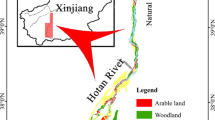Abstract
The Ecological Water Requirement (EWR) of desert oasis is the amount of water required to maintain a normal growth of vegetation in the special ecosystems. In this study EWR of the Ejina desert oasis is estimated through the relational equation between normalized difference vegetation index (NDVI), productivity and transpiration coefficient, which was established by a combination of the RS, GIS, GPS techniques with the field measurements of productivity. The results show that about 1.53×108 m3 water would be needed to maintain the present state of the Ejina Oasis, and the ecological water requirement would amount to 3.49×108 m3 if the existing vegetation was restored to the highest productivity level at present. Considering the domestic water requirement, river delivery loss, oasis vegetation water consumption, farmland water demand, precipitation recharge, etc., the draw-off discharge of the Heihe River (at Longxin Mount) should be 1.93×108–2.23×108 m3 to maintain the present state of the Ejina Oasis, and 4.28×108–5.17×108 m3 to make the existing vegetation be restored to the highest productivity level at present.
Similar content being viewed by others
References
Kang E S, Cheng G D, Song K C, et al. Simulation of energy and water balance in Soil-Vegetation-Atmosphere Transfer system in the mountain area of Heihe River Basin at Hexi Corridor of northwest China. Sci China Ser D-Earth Sci, 2005, 48(5): 538–548
Xia J, Sun X T, Feng H L. Challenge in the study of ecological water requirement in West China. China Wat Resour, 2003, 9: 57–60
Covich A P. Water and ecosystems. in: Gleick P H, ed. Water in Crisis. Oxford: Oxford University Press, 1993. 40–55.
Gleick P H. Water in crisis: paths to sustainable water use. Ecol Appl, 1996, 8: 571–579
Yang Z F, Cui B S, Liu J L, et al. Theory, Method and Practice of Eco-environmental Water Requirement (in Chinese). Beijing: Science Press, 2003
Yang Z F, Cui B S, Liu J L. Estimation methods to eco-environmental water requirements: Case study. Sci China Ser D-Earth Sci, 2005, 48(8): 1280–1292.
Liu C M, Chen Y Q, Li L J, et al. Problems and Techniques in the Hydrological Research of China (in Chinese). Beijing: Science Press, 2001
Li L J, Zheng H X. Environmental and ecological water consumption of river systems in Haihe-Luanhe Basins. Acta Geogr Sin (in Chinese), 2000, 55: 496–500
Jia B Q, Xu Y Q. The conception of the eco-environmental water demand and its classification in arid land-taking Xinjiang as an example. Arid Land Geogr (in Chinese), 1998, 21: 8–12
Zhao W Z, Cheng G D. Review of several problems on the study of eco-hydrological processes in arid zones. Chin Sci Bull, 2002, 47: 353–360
Wang R H, Song Y D, Fan Z L, et al. Estimation on ecological water demand amount in four sources and one main stream area of Tarim Basin. J Soil Wat Conserv (in Chinese), 2001, 15: 19–22
Chen Y N, Zhang X L, Zhu X M, et al. Analysis on the ecological benefits of the stream water conveyance to the dried-up river of the lower reaches of Tarim River, China. Sci China Ser D-Earth Sci, 2004, 47: 1053–1064
Goodrich D C, Scot R, Qi J, et al. Seasonal estimates of riparian evapotranspiration using remote and in situ measurements. Agr Forest Meteorol, 2002, 105: 281–309
Zhao W Z, Chang X L, He Z B. Responses of distribution pattern of desert riparian forests to hydrologic process in Ejina Oasis. Sci China Ser D-Earth Sci, 2004, 47(Supp.): 21–31
Huang Z S, Shen W S. Plant-Water Relation and Drought Tolerance in arid Zone (in Chinese). Beijing: China Environment Science Press, 2000. 31–39
Sun R Y, Li B, Zhu G X, et al. General Ecology (in Chinese). Beijing: Higher Education Press, 1993. 41–48
Su P X, Zhang L X, Du M W, et al. Photosynthetic character and water use efficiency of different leaf shapes of Populus euphratica and their response to CO2 enrichment. Acta Phytoecol Sin (in Chinese), 2003, 27: 34–40
Cui S B. A Research on issues of water demand for ecological environment. Water Utilization of China (in Chinese), 2001, (8):71–74
Wang F, Wang H, Cheng M J, et al.. A study of ecological water requirements in Northwest China Part II: Application of remote sensing and GIS. J Nat Resour (in Chinese), 2002, 17: 129–137
Yang W, Wang E D, Chen C. Application of BP neural network to forecasting urban water demand. Res Sur Environ (in Chinese), 2003, 24: 217–22
Author information
Authors and Affiliations
Corresponding author
Additional information
Spported by the Knowledge Innovation Program of the Chinese Academy of Sciences (Grant No. KZCX3-SW-329) and the National Natural Science Foundation of China (Grant No. 40235053)
Rights and permissions
About this article
Cite this article
Zhao, W., Chang, X., He, Z. et al. Study on vegetation ecological water requirement in Ejina Oasis. SCI CHINA SER D 50, 121–129 (2007). https://doi.org/10.1007/s11430-007-2035-z
Received:
Accepted:
Issue Date:
DOI: https://doi.org/10.1007/s11430-007-2035-z




